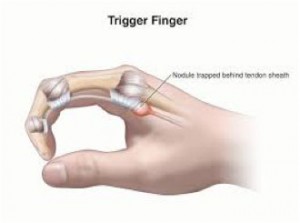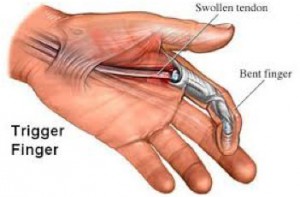Trigger Finger Repair
 If you have trigger finger, the tendon becomes momentarily stuck at the mouth of the tendon sheath tunnel when you try to straighten your finger. You might feel a pop as the tendon slips through the tight area and your finger will suddenly shoot straight out. The flexor tendon can become irritated as it slides through the tendon sheath tunnel. As it becomes more and more irritated, the tendon may thicken and nodules may form, making its passage through the tunnel more difficult. The tendon sheath may also thicken, causing the opening of the tunnel to become smaller.
If you have trigger finger, the tendon becomes momentarily stuck at the mouth of the tendon sheath tunnel when you try to straighten your finger. You might feel a pop as the tendon slips through the tight area and your finger will suddenly shoot straight out. The flexor tendon can become irritated as it slides through the tendon sheath tunnel. As it becomes more and more irritated, the tendon may thicken and nodules may form, making its passage through the tunnel more difficult. The tendon sheath may also thicken, causing the opening of the tunnel to become smaller.
Preparation for Trigger Finger Repair
Your health care provider will talk to you about how to prepare for surgery. He may tell you not to eat or drink anything after midnight on the day of your surgery. He will tell you what medications to take or not take on the day of your surgery before surgery; you will need to obtain clearance from your regular doctor if you have medical problems. You may be required to obtain some basic tests for screening before the surgery. Basic blood tests, a chest x-ray, and an EKG may be required depending on your health.
Surgical Procedure
The goal of surgery is to widen the opening of the tunnel so that the tendon can slide through it more easily. This is usually done on an outpatient basis, meaning you will not need to stay overnight at the hospital. Most people are given an injection of local anesthesia to numb the hand for the procedure. The surgery is performed through a small incision in the palm or sometimes with the tip of a needle. The tendon sheath tunnel is cut. When it heals back together, the sheath is looser and the tendon has more room to move through it.
Recovery
 Most people are able to move their fingers immediately after surgery. It is common to have some soreness in your palm. Frequently raising your hand above your heart can help reduce swelling and pain. Recovery is usually complete within a few weeks, but it may take up to 6 months for all swelling and stiffness to go away.
Most people are able to move their fingers immediately after surgery. It is common to have some soreness in your palm. Frequently raising your hand above your heart can help reduce swelling and pain. Recovery is usually complete within a few weeks, but it may take up to 6 months for all swelling and stiffness to go away.
If your finger was quite stiff before surgery, physical therapy and finger exercises may help loosen it up.
What are the risks of Trigger Finger Repair
As with any surgical procedure, complications can occur, some possible complications may include, but are not limited to the following:
- Incomplete extension — due to persistent tightness of the tendon sheath beyond the part that was released.
- Persistent triggering — due to incomplete release of the first part of the sheath.
- Bowstringing — due to excessive release of the sheath.
